By Jeffrey A. Rendall, Photos by Kevin Gaydosh
CARTHAGE, NC – Dan Maples has been involved with golf course design his entire life (let’s just say it runs in the family), so when he says a project was probably the most unique to build that he’s ever been associated with, it means something.
Maples was speaking of his creation at Little River Golf & Resort (also known as Little River Farm), just a few miles north of the village of Pinehurst in the Sandhills of North Carolina. But don’t get the wrong impression – though Little River may have been the most challenging to construct, it doesn’t mean it wasn’t worth it.
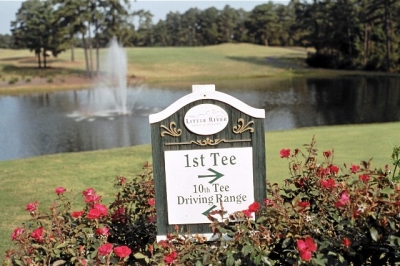 |
| Little River's first tee is located just a short distance from the pro shop - and like everything else at the facility, is worry-free and convenient. |
“People that see the course aren’t going to be interested in all we went through to construct it,” Maples elaborated thoughtfully, “but it really was probably the most unique situation that I’ve ever been involved with – you could probably write a book on it.”
At first glance, it’s true – you’d never suspect that there was anything arduous about Little River, a golf course facility with many different looks and all the elements you’d want from a layout in the Pinehurst area, or anywhere else for that matter. The golf course is very spread out without feeling disjointed, and the holes vary from short and tree-lined to long and wide open. Bring all parts of your game to Little River and expect to use them.
It almost seems as though the property was ‘created’ for golf – but that’s not how it started out, even in a place as renowned to the game as Pinehurst.
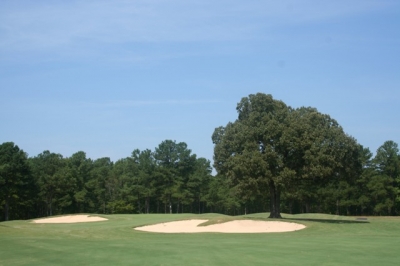 |
| A huge oak tree splits the par four 10th hole in half - one of those Maples design elements that's hard to 'miss' at Little River. |
Little River’s Director of Golf, Marvin Waters, provides the historical background on the land: “Little River Farm was built in 1927 as a working farm providing dairy products to the Carolina Hotel, now known as the Pinehurst Resort and Hotel. It served as a dairy farm until around 1950, when ownership changed hands and it then became a horse farm.”
The property’s 650 acres were perfectly suited for horses, and Maples himself remembers seeing it as a youth with ‘miles and miles’ of white fences, a tribute to the land’s equestrian gifts. All kinds of horses were raised there – Trotter’s, Pacer’s and Thoroughbred’s – and Little River Farm was even nationally known, as a host for the US Olympic equestrian trials until the mid 80’s.
It’s devoted to golf now, but the aura of horses still looms – mainly due to the remnants of three horse tracks that are still there. For example, Little River’s practice facility is completely encircled by what was once the half-mile trotter track.
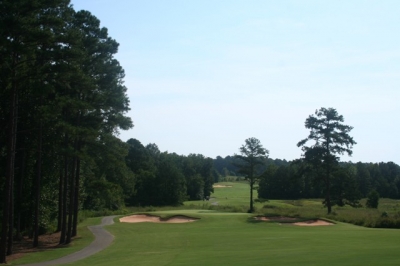 |
| The green of the par four 4th hole looks unassuming enough from this view - but it's the tee shot on this hole where you've really got to weigh your options. |
Little River’s golf track was built in 1995 and opened after a grow-in period in 1996. Maples called it a ‘turnkey’ project, meaning his firm was involved in all aspects of the golf course from planning to construction to fine-tuning – turning it over as a finished product, ready to play.
It wasn’t exactly ‘rustic’ at first, though the pro shop and offices occupied a renovated horse barn until 2005, when a new 20,000 square foot clubhouse opened in time for the mass of visitors coming to town to witness the U.S. Open being held over on Pinehurst #2. Along with the clubhouse, sixty-four condos were added at that time and are now owned and managed by Little River’s ‘new’ owner, Oceanico Group USA – which also brought in Troon Golf to look after the golf operations.
Together, Troon and Oceanico are seeking to make Little River into a destination onto itself – and based on what we saw, they’ve got a real good start.
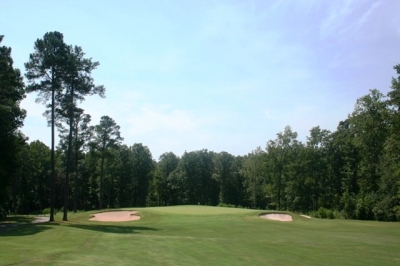 |
| The 581-yard, par five 11th hole is Little River's longest - but it's downhill most of the way, and pretty wide at that. |
But it all begins with a top notch golf product, and that’s where Maples comes in. Being a native of the area, Maples was familiar with Little River Farm, and had thought for a long time that it would be a perfect place to put a golf course. His chance to turn dream to reality came in the mid-90’s when the Mayor of nearby Carthage (Larry Caddell) approached Maples about developing the property for golf.
The fact that the land had been a horse farm added to its charm, and Maples said they tried to preserve as much of that rolling, horse-country quality as possible. “There were a great many horse barns on the property, and we tried whenever possible to keep them – we always try to make each golf course unique to its piece of property.”
“There was a lot of change of elevation in the land, a lot of relief – a lot of different atmospheres to play through,” Maples added.
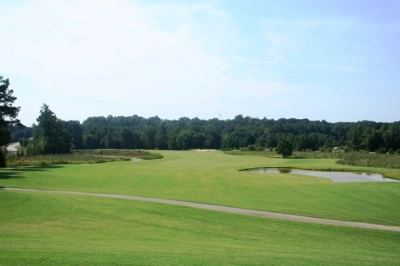 |
| Keep it straight and narrow on the par five 6th hole - or else you'll likely find the trouble lurking all around. |
The atmospheres can be roughly divided into two types – the front nine is fairly open and even includes some marsh land (including several holes along the Little River), and the back nine winds through pines and hardwoods, where the holes are defined by cut tree-lines. Maples said the back nine’s land used to be a quarry, where the previous owners used to mine gravel – which resulted in several deep lakes and ponds that were already in existence at planning and construction time.
Maples said it was natural to work the holes around the water – and because of environmental restrictions and the depth of the ponds (about 35 feet), not much could be changed in any case. The quantity of water also makes for some real difficult long carries (primarily from the back tees), which Maples said they tried to work around: “Those were some large lakes out there, so we put the ladies tees on the other side of the carries – but if you moved the men over there, it made it too short a hole in most instances.”
As a result, Little River’s par five 17th hole offers one of the longest carries I’ve ever seen from the tee – a stunning 230 yards to safety from the elevated back tees. Again, there is some height to help with the distance, but the golf ball’s got to be screaming the whole way when trying to fly all that water.
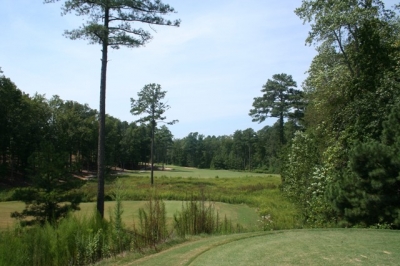 |
| From the back tee of the short par four 14th hole, it looks like there's trouble all around - and there is. |
Another prominent feature at Little River that also tends to show up at other Maples designs is the use of large trees to define golf holes in certain spots on the course. Such is the case on the dogleg left par four fourth hole, and again on the par four tenth hole – both of which are dominated by large trees that force you to choose from the tee the best way to play the hole.
Maples says the trees are great, but the holes aren’t ‘centered’ on them alone. “When we’re in the beginning processes of designing a course, we always pick out the prominent trees and use them where possible. The big beautiful oak tree on the tenth hole (that literally splits the hole) is over a hundred years old, and would’ve been a shame to cut it down.”
“But we always try to imagine the hole without the tree, as Mother Nature tends to take the trees out in many cases. If it’s a good hole even without the tree there, then we know it’ll work regardless – and it’s always a good thing to save them if possible,” Maples said.
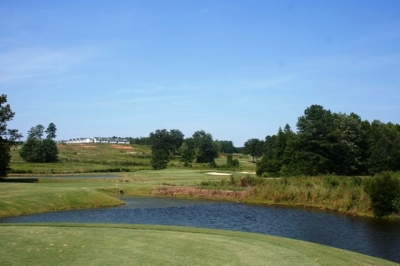 |
| The green looks tiny from the tee of the par three 8th hole - and without many trees to shield it, the wind will play havoc with your tee shot. |
Because of the big lakes, tight marsh (in spots) and varied terrain, the course plays longer than its 7018-yards would indicate. If you add in a pretty decent breeze (like the day we played), some holes become very difficult to conquer, such as the uphill 459-yard par four ninth, which played into the wind as well.
The greens (with Crenshaw bent grass) are large and accessible – and in great condition – but like the topography, can be severe in spots. Just because you’re on the green doesn’t mean your work’s done on the hole – putting is key at Little River.
Waters says it’s the elevation changes that set Little River apart from other golf courses in the area. “You just don’t see the type of rolling terrain that we have a lot in the Pinehurst area – elevation changes on the seventeenth hole alone are ninety feet from tee to green.”
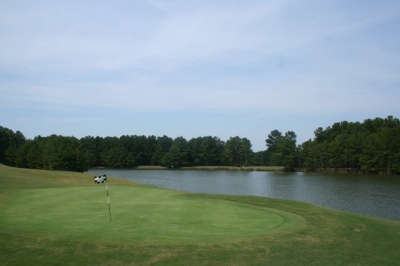 |
| It's hard to tell from this view, but there's a full water carry (200+ yards) going into the par three 16th hole - take plenty of club off the tee. |
There’s more: “One of the most unique features of our golf course/resort is the configuration of our villas relative to the golf course – our golfers can park their car upon arrival and walk to rooms, the clubhouse, practice tee, first tee and bar and dining room all very easily – there’s a lot of convenience here as well,” Waters explained.
Hole highlights include the aforementioned par four fourth hole, which comes after a creatively done opening stretch that goes par four, par three, par five. The fourth measures only 386-yards and downhill, but the key is how much of the dogleg to try and cut with your drive – factoring in the large tree on the left-hand side of the landing area, of course. In addition, Waters says the closer you are to the green, the harder your second shot will be.
The par five sixth is one of those holes that confounds long hitter and short hitter alike. It stretches to 560-yards from the back tee, but can be shortened somewhat with a well placed tee shot that avoids a pond to the right and marsh long and left. Going for the green is risky as the marsh juts in from the left and there are trees to the right. The lay-up is no gimme either – a challenging and thought-provoking hole.
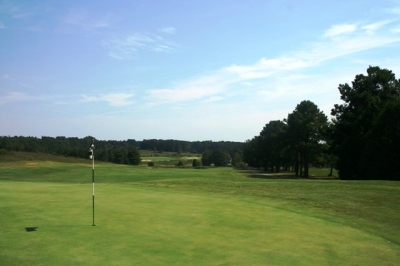 |
| The par four ninth hole is long (459-yards) and uphill - and if the wind is against you (as it was for us), it's tough to reach it in two. |
Moving to the back, the short par four (334-yards) fourteenth hole will certainly be one you’ll remember. The tee shot landing area is squeezed in the farther you hit it – it’s much better to play it safe and lay back to the wide part of the fairway. If you’re too far left off the tee, trees will block your approach – and if you’re too far right, you flirt with the trees.
The par five seventeenth hole is one of the most unique holes you’ll see in a golfing lifetime. Waters describes it: “It drops nearly ninety feet from tee to green (including the massive carry off the tee over water), and a well executed drive will tempt players to go for the green in two. Any attempt to go for it would have to be nearly perfect, however, as the green is elevated and any long iron or fairway wood that misses the mark will likely bound out of play. This hole is very attractive unless you are out of play.”
Truer words were never spoken – you’ll either love it… or… not.
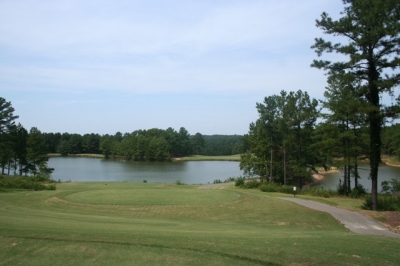 |
| There's 230-yards of water to carry off the tee of the par five 17th hole - no wonder it's rated the back nine's most difficult hole. |
But love or hate would not describe the overall experience at Little River – which is much closer to the former than the latter. The new owners (Oceanico Group USA) are going the extra mile to upgrade the property, too.
“2008 brought many improvements to the golf course,” Waters explained. “There was a $500,000 renovation that consisted of building new tee boxes on eleven holes – to allow for multiple sets of tees. There was also an overall beautification program that saw many areas on the golf course cleared of underbrush and wooded areas adjacent to many holes were thinned of small trees and underbrush. Finally, all new golf course equipment was put into place in 2008.”
It all makes for a terrific and unique golfing experience – Little River is certainly worthy of consideration for your next visit to Pinehurst.
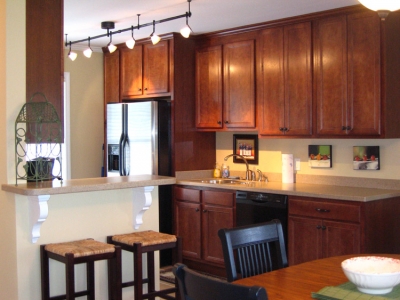 |
| The Pit condos offer a full kitchen -- very convenient. |
Where We Stayed
On our most recent visit to Pinehurst, we decided to stay a bit off the beaten path at a place that we knew would be convenient to all the golf courses we were going to play, would provide plenty of room for our group (which included kids), some peace and quiet, and most importantly, all the comforts of home.
For that reason, we chose The Condos at The Pit (which was also one of the golf courses we played), located just south of the Village of Pinehurst and close enough to the area’s amenities -- yet far enough ‘away’ to make it feel like a real vacation spot.
The Pit Condos are all located on the Pit Golf Course’s par three seventh hole, and are within walking distance to the clubhouse. These two and three-bedroom condos sleep two per bedroom (for golf groups) with two queen beds per room.
Each condo has a fully equipped kitchen with stainless steel appliances, flat panel TV in the den with VCR/DVD player, a TV in each bedroom, digital phone for free long distance, free high speed internet connection, full size washer & dryer, linens, towels, and a balcony with outdoor seating.
We took advantage of the balcony to enjoy the pleasant early fall evenings – highly recommended! The kitchen facilities also helped us manage meal-time in a convenient, budget-conscious way.
For condo rentals or golf packages, please contact Maples Golf Packages at 800-889-5323 or visit www.MaplesGolf.com.
Details:
500 Little River Farm Road
Carthage, NC 28327
Phone: (910) 949-5010
Toll Free: (888) 766-6538
Website: www.LittleRiver.com; www.OceanicoGroup.com
Course Designer: Dan Maples
Director of Golf: Marvin Waters
Course Superintendent: Christopher Lassiter
Tees/Yardage/Slope/Rating
Blue 7018 135/73.4
White 6430 128/70.0
Gold 5516 111/64.8
Red 4850 122/68.7
Rates:
For current rates, check the Little River Website. For package information, call Alan Trepcyk at (910) 949-4600, or atrpcyk@troongolf.com to discuss custom packages.
| Related Links | Comments on this article? | |
|
Maryland National Golf Club Hollow Creek Golf Club Rocky Gap Resort PB Dye Golf Club in Ijamsville Whiskey Creek Golf Club |
E-mail Jeff Rendall, Editor: jrendall@golftheunitedstates.com |












